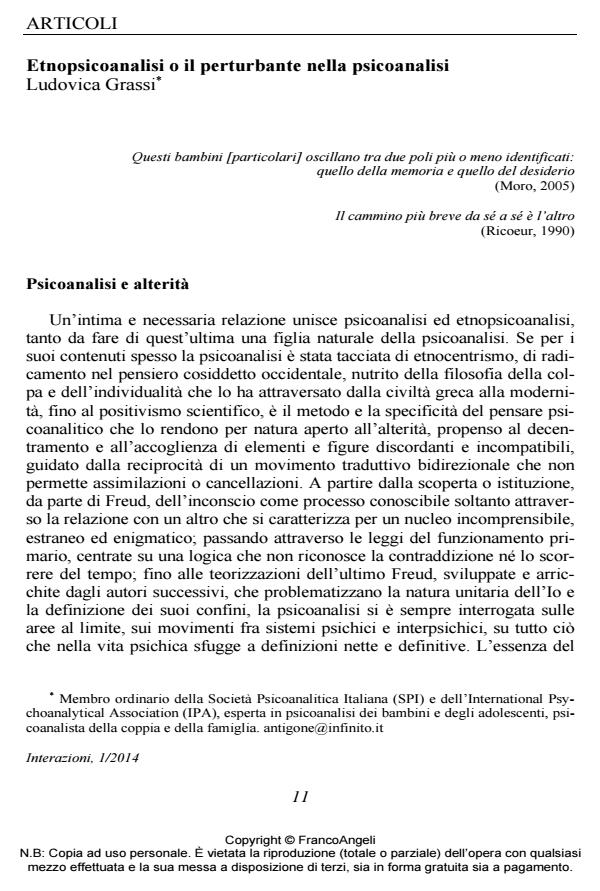Ethnopsychoanalysis, that is, the uncanny in psychoanalysis
Journal title INTERAZIONI
Author/s Ludovica Grassi
Publishing Year 2014 Issue 2014/1 Language Italian
Pages 10 P. 11-20 File size 41 KB
DOI 10.3280/INT2014-001002
DOI is like a bar code for intellectual property: to have more infomation
click here
Below, you can see the article first page
If you want to buy this article in PDF format, you can do it, following the instructions to buy download credits

FrancoAngeli is member of Publishers International Linking Association, Inc (PILA), a not-for-profit association which run the CrossRef service enabling links to and from online scholarly content.
Ethnopsychoanalysis stems from the primal disposition of psychoanalysis to confront otherness and what is uncanny in the familiar. Both disciplines acknowledge the role of unconscious and affects (specifically anxiety) as pivotal in clinics and theory construction. The complementary approach, originally introduced by Devereux, needs both a psychoanalytical and an anthropological frame of reference, without leaving aside the uniqueness of the subject in the therapeutic relationship. A transcultural setting and the work of nostalgia, due to their transitional qualities, may set in motion again subjectivation processes, which were blocked or distorted by migration and associated traumas.
Keywords: Ethno-psychoanalysis, otherness, migration, work of nostalgia.
- Beneduce R. (2007). Etnopsichiatria. Sofferenza mentale e alterità fra storia, dominio e cultura. Roma: Carocci.
- De Martino E. (1962). Furore Simbolo Valore. Milano: Il Saggiatore.
- De Vita C., Grassi L. (2014). Migration ruptures: nostalgia between mourning and melancholia. 27th Annual EFP Conference: “Ruptures”, Torino, 10-13 Aprile.
- Devereux G. (1967). Dall’angoscia al metodo nelle scienze del comportamento. Roma: Istituto della Enciclopedia Italiana, 1984.
- Devereux G. (1970). Saggi di etnopsichiatria generale. Roma: Armando, 1978.
- Douville O. (2014). Le figures de l’Autre. Pour une anthropologie clinique. Paris: Dunod.
- Fabietti U., Malighetti R., Matera V. (2012). Dal tribale al globale. Introduzione all’antropologia. Milano: Mondadori.
- Fanon F. (1964). Pour la révolution africaine. Écrits politiques. Paris: La Découverte, 2001.
- Foucalt M. (1966). Le parole e le cose. Milano: Rizzoli, 1967. Freud S. (1919). Il perturbante. In: OSF, 9. Torino: Bollati Boringhieri.
- Grinberg L., Grinberg R. (1982). Psicoanalisi dell’emigrazione e dell’esilio. Milano: Franco Angeli, 1990.
- Inglese S. (1996). Introduzione. In: Nathan T. (1993). Principi di etnopsicoanalisi. Torino: Bollati Boringhieri, 1996.
- Kaës R. (2005). Il disagio del mondo moderno e la sofferenza del nostro tempo. Saggio sui garanti metapsichici, Psiche, 2: 57-65.
- Laplanche J. (1984). Nuovi fondamenti per la psicoanalisi. Roma: Borla, 1989.
- Laplanche J. (1993). Fra seduzione e ispirazione: l’uomo. Roma: La Biblioteca, 2002.
- Lévi-Strauss C. (1965). Introduzione all’opera di Marcel Mauss. In: Mauss M. (1950). Teoria generale della magia e altri saggi. Torino: Einaudi, 1965.
- Memmi A. (1957). Portrait du colonisé, précédé du Portrait du colonisateur. Paris: Gallimard, 1985 (ed. or.).
- Moro M.R. (1994). Genitori in esilio. Psicopatologia e migrazioni. Milano: Cortina, 2002.
- Moro M.R. (2000). Bambini di qui venuti da altrove. Saggio di transcultura. Milano: Franco Angeli, 2005.
- Nathan T. (1993). Principi di etnopsicoanalisi. Torino: Bollati Boringhieri, 1996.
- Remotti F. (2010). L’ossessione identitaria. Roma-Bari: Laterza.
- Ricoeur P. (1990). Sé come un altro. Milano: Jaca Book, 1993.
- Rosso C. (2013). «Identità in transito» o «lacerazione identitaria»? Il dolore dello sradicamento e sue ripercussioni nell’esperienza migratoria, Psiche, 1: 1-16.
- Winnicott D.W. (1971). La sede dell’esperienza culturale. In: Gioco e realtà. Roma: Armando, 1974.
Ludovica Grassi, Etnopsicoanalisi o il perturbante nella psicoanalisi in "INTERAZIONI" 1/2014, pp 11-20, DOI: 10.3280/INT2014-001002